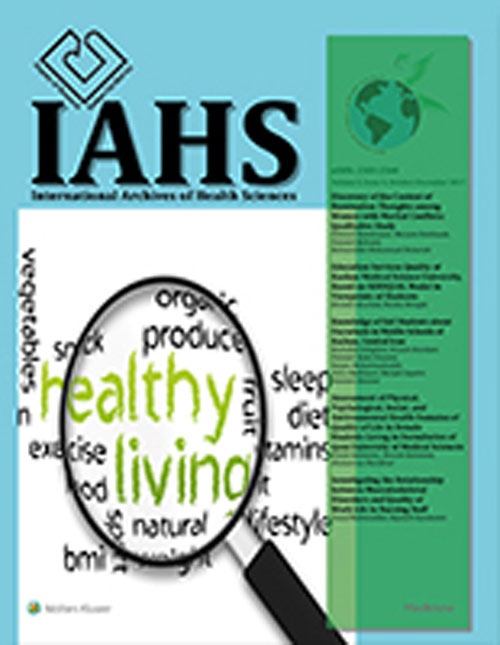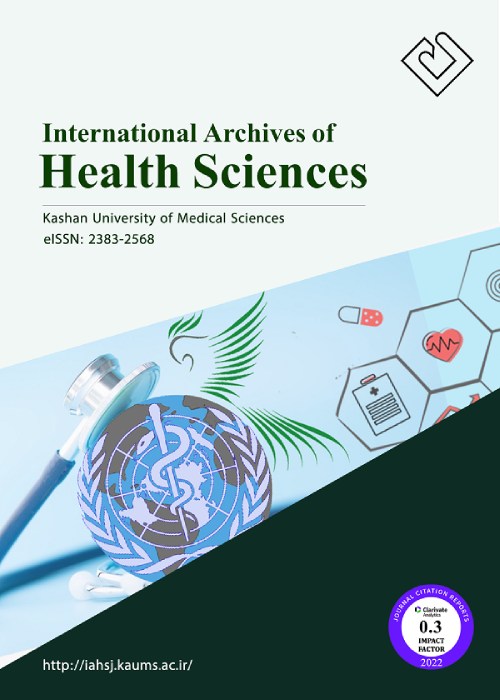فهرست مطالب

International Archives of Health Sciences
Volume:4 Issue: 4, Oct -Dec 2017
- تاریخ انتشار: 1396/10/08
- تعداد عناوین: 5
-
-
Page 79Background And ObjectivesRumination is the predisposing and continuing factor of depression. Since women are prone to rumination, the purpose of this study was to discover the content of rumination thoughts among women with marital conflicts.Materials And MethodsThis study was conducted on a qualitative method basis, and target society was composed of women with marital conflicts and rumination. The sample was selected from among those referring to Isfahan counseling centers and was statured with 15 persons through purposeful sampling method. Information was collected through semi-structured interviews and data analysis was performed based on thematic analysis.ResultsFive main categories were obtained from data analysis: root cause analysis, feeling incompetence, remembrance of bitter memories, negative emotions, and hesitation in continuation of couple relationship.ConclusionThe findings indicate that when women with marital conflicts become ruminant, the course of rumination is so that it could harm continuation of their couple relationship. Therefore, to reduce this damage, interventions are required to intervene effectively in this process.Keywords: Depression, marital conflicts, rumination, rumination thoughts
-
Page 84IntroductionSustainable development of higher educational systems, as a dynamic system, requires a coherent moderate growth both in qualitative and quantitative dimensions. Since students are the major clients of higher education systems and their perspectives can play a key role in the quality promotion of the services; this study has been conducted based on SERVQUAL model aiming at the assessment of educational services quality in Kashan Medical Science University in 2016.
StudyMethodologyA total of 212 students of Kashan Medical Science University were selected with a population of 616 subjects through random sampling, using Morgan tables for this descriptive-analytical research. Data collection tools were the standard SERVQUAL questionnaire composing of three sections of basic information and 28 items, according to Likert six-option scale for the measurement of services quality current and desired expected conditions. The difference between the average of current and desirable statuses was measured as the services gap. Descriptive deductive statistics were used to analyze the obtained data.ResultsThe students aged averagely 23 ± 1.8, 65% (138 subjects) were female, and 35% (74 subjects) were male. About 72% (153 subjects) were single, and 28% (59 subjects) were married. The obtained results revealed that there was a negative gap in all dimensions of quality. The results also showed that the minimum gap obtained for learning assist tools (physical and tangibility dimensions) with an amount of −0.38 and the maximum gap for guide instructor availability once needed by the students (accountability dimension) with an amount of −2.42. Total mean of perceptions and expectations measurement for the students obtained 2.28 and 3.85, respectively.ConclusionRespecting the negative gap obtained for all dimensions of educational services quality and insufficiencies to meet the student's expectations, it is recommended to assign further resources along with appropriate management initiations, modification, and rearrangement of the services providing models to improve the quality of educational services for higher education centers all around the country.Keywords: Educational services quality, gap, SERVQUAL, students -
Page 89Background And AimDue to the high prevalence and worldwide distribution of Enterobius vermicularis and its readily transmission among children, parent's knowledge and health education have an important role in restriction and infection control. This study was performed to evaluate the girl student's knowledge about transmission, symptoms, and prevention of oxyuriasis in 20122013 in Kashan, Central Iran.Materials And MethodsIn this cross-sectional study, a total of 500 students in three levels of middle schools were studied. To evaluate the student's knowledge level of oxyuriasis, the standardized questionnaire was distributed and completed. Data were analyzed using statistical software SPSS.ResultsAmong three levels of students of middle schools, 67.6% of students had average awareness (information), 17.4% had weak information, and 15% had high information. In the assessment of the level of awareness in the first-level students, 23.41% of the students had weak information, 66.4% had average information, and 10.12% had high information. In the second-level students, 12.57% had weak information, 73.14% had average information, and 14.28% had high information. In the third-level middle-school students, 16.76% of students had weak knowledge, 62.87% had average knowledge, and 20.35% had high knowledge.ConclusionThe result of this study shows that knowledge of middle-school students about this infection is good but not sufficient, and it is necessary for teachers and health officers in schools to increase hygienic knowledge of the students and to train about this infection to decrease the damage of personal and social problems.Keywords: Awareness, Iran, Kashan, students, oxyuriasis
-
Page 93Aims: Considering significant number of students, especially female students consisting young stratum of the society, there is the increased possibility of mental damages and the direct effect it can have on their quality of life (QOL). The present study aimed to investigate the QOL in female students living in dormitories of the University of Medical Sciences in Qom University of Medical Sciences.Materials And MethodsThis study is a cross-sectional study conducted in 2016 on 300 students of the Qom University of Medical Sciences selected using quota sampling. Data gathering tool was the World Health Organization QOL-BREF questionnaire containing 26 items. Statistical data were analyzed using descriptive and inferential statistics of SPSS software.ResultsIn general, the mean score of students in the four domains of QOL was respectively related to physical health (14.42 ± 2.42), social health (13.30 ± 3.33), environmental health (13.11 ± 2.95), and psychological health (13 ± 2.81), and also, there was a significant relationship between QOL and age (PConclusionThis study showed that the lowest area of QOL was associated with psychological health; therefore, to increase the QOL in this dimension; the periodical evaluation of the mental health is recommended. Appropriate training to create psychological adjustment in student dormitories can also improve the QOL.Keywords: Qom, quality of life, students
-
Page 97Aims: The high prevalence of musculoskeletal disorders caused by work is a common problem in nurses. The quality of life is effective, job satisfaction, and everyday life of nurses. The study was conducted with the aim of determining the relationship of musculoskeletal disorders and the dimensions of the quality of nursing life in the hospitals in Southern regions of West Azarbaijan in 2017.Materials And MethodsIn this descriptive-analytical study, 100 nursing staff working in southern regions of West Azarbaijan hospitals was chosen randomly. The data gathering tool was a two-part tool using a Nordic questionnaire and a quality of life questionnaire. Data were analyzed using SPSS software, t-test, and Pearson correlation coefficient.ResultsThe results showed that the most musculoskeletal disorders in the nursing staff were in the lumbar (50%). In addition, individual factors such as age, work history, type of working system, body mass index, and sex are effective in the increase of musculoskeletal disorders (PConclusionConsidering that there is a relationship between skeletal muscle-muscle disorders and living quality of life, nursing managers should establish a correct relationship with the staff and provide a suitable environment to reduce physical and psychological stresses caused by work and increase the quality of working life.Keywords: Musculoskeletal disorders, nursing staff, quality of work life


